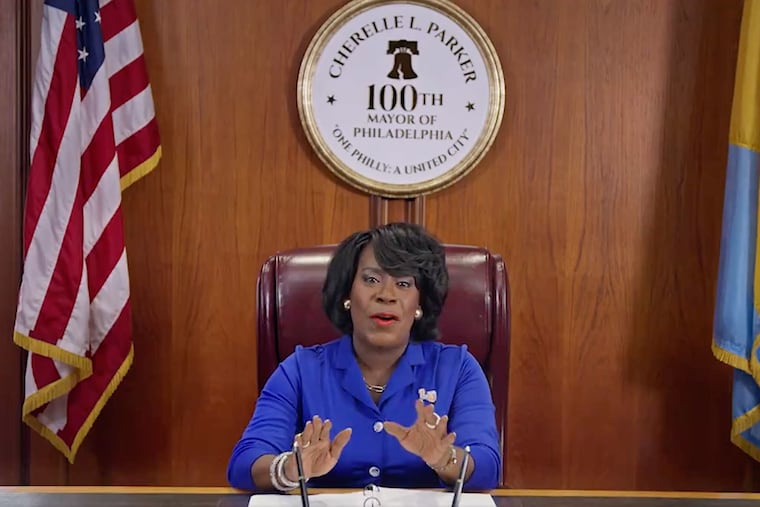Now that Mayor Parker backs the Sixers arena, whither Chinatown? | Editorial
In a message Wednesday that overhyped the benefits of the arena while breezing past the very real challenges, Cherelle L. Parker announced her support of the 76ers' proposal.

That came out of nowhere.
After more than two years of protests, studies, and meetings, Mayor Cherelle L. Parker abruptly announced Wednesday that she reached an agreement with the Sixers to build an arena on East Market Street.
The surprise announcement left as many questions as answers. Namely, what about Chinatown?
In a video message, Parker told Chinatown residents that she sees them. But the staged delivery, with Parker sitting behind her City Hall desk, felt more like she was looking past them the whole time.
The mayor said more details are forthcoming. That was the biggest understatement in a message that overhyped the benefits of the arena while breezing past the very real challenges.
Given that Parker always seemed to favor the project, her support was not a surprise. But the way the deal unfolded showed that the strong opposition from many in the Chinatown community did not seem to matter.
To be sure, there are strong arguments for building the arena on Market Street. But there are also major drawbacks. Sadly, the opposing sides spent more time talking past each other instead of searching for a compromise that benefits everyone.
» READ MORE: Sixers arena proposal should not be a zero-sum game | Editorial
No doubt, the Sixers’ offer to fund the $1.55 billion project and not ask for any city tax dollars was a huge allure. The prospect of a new arena will pump much-needed economic activity along a shabby section of Market Street that has struggled for decades and showed no signs of turning around.
But sports arenas are not economic engines. Study after study — along with the reality of many such sports venues built around the country — has shown that these facilities do not attract much in the way of additional development or jobs.
Yes, the arena will provide thousands of good-paying union construction jobs. But those jobs are temporary, and they will exist wherever the arena is built.
A Center City arena will also bring traffic and parking challenges. Fans are used to driving to the stadium complex in South Philadelphia. While the arena would sit above a major public transit hub, it is unclear if enough fans will change their driving habits.
Perhaps the traffic hurdles could be overcome. But a bigger challenge is, what will happen to Chinatown?
The city’s own economic impact study — which was paid for by the Sixers — found that half of the small businesses in Chinatown will lose economically if the arena is built. The businesses most in danger are in the grocery, wholesale, health care, and financial sectors.
Those are real jobs, real people, and real families who could be put out of business so millionaires can play a game and billionaires can profit.
Is that a wise or fair trade-off?
Meanwhile, only one out of five small businesses would benefit from the project — mostly those in entertainment, hotels, and food. While the studies found the arena would not displace residents because no housing would be demolished, gentrification and increased rents could lead to displacement over time.
Even in the short term, the yearslong construction will result in street closures and traffic congestion. That could disrupt many surrounding businesses and put them at risk.
The Sixers offered $50 million as part of a community benefit agreement. While the offer seems generous, it did not sway the strong opposition in Chinatown.
Details of the agreement were not disclosed, and it is unclear if the funding would be enough to protect the neighborhood. It is also unclear who will control the money, or how it will get spent.
» READ MORE: Impact studies underscore the strong divide on Sixers arena. City Hall must now step into the breach. | Editorial
The deal now goes to City Council, where safeguards for Chinatown and many other details must be hammered out. Until Chinatown is protected, moving forward with the arena seems wrongheaded. Parker’s bold push to impose the proposal on Chinatown will only create more anger and mistrust.
The city has a long and fraught history with development projects that destroyed neighborhoods in the name of progress, including the death of the mostly African American “Black Bottom” in West Philadelphia in the 1960s to make way for the University City Science Center and University City High School.
Parts of Chinatown were razed for the construction of the Vine Street Expressway in the 1980s. It could be argued the highway was an essential public good that benefited commuters in Philadelphia, the western suburbs, and New Jersey.
But a privately owned sports venue that mainly profits a few is different. So far, there is little evidence that the benefits of the arena outweigh the potential destruction of one of the city’s oldest ethnic enclaves.
Of course, there was a risk if the city blocked the arena. New Jersey offered $800 million in economic incentives for the Sixers to build in Camden. And Delaware has even made a pitch.
Parker certainly didn’t want to be the mayor who lost the Sixers. Instead, she could be the mayor who loses Chinatown.